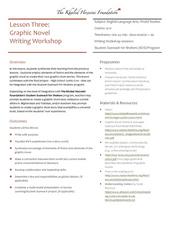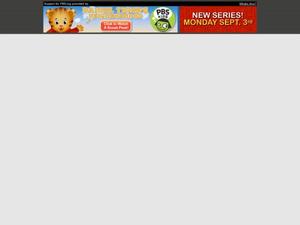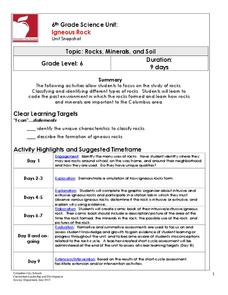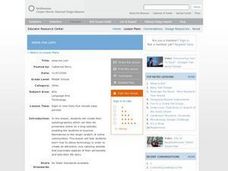ReadWriteThink
Comics in the Classroom as an Introduction to Narrative Structure
A picture is worth a thousand words, but a comic strip combines both images and words for the ultimate narrative effect. After reading The Three Little Pigs and deciphering the plot elements, elementary readers work through four...
Curated OER
Graphic Novel Writing Workshop
Khaled Hosseini’s video “Using Real People and Events” motivates learners to reflect on their own experiences and to use those experiences as the basis of a graphic novel that expresses a universal truth. The richly detailed plan...
Curated OER
Comic Book Project
Students write a comic. In this writing lesson, students discuss comic books and why they continue to be so popular. Students create a comic book using an imaginary character. Students must present a problem and solution in their comic.
Curated OER
PowerPoint Presentation of Fudge Comic Strips
Fourth graders create comic strips for presentation to the class. They make drawings, record them digitally, transfer them to a KidPix program and then arrange them in a PowerPoint presentation in a comic strip format.
Ontario
Reading Graphic Text
Do students really need to be taught how to read cartoons, comic books, and comic strips? Yes. Just as they need to learn how to read other forms of graphic text such as diagrams, photos, timetables, maps, charts, and tables. Young...
Curated OER
Applying Elements of the Graphic Novel to Traditional Literature
The Khaled Hosseini Foundation, dedicated to providing humanitarian assistance for the people of Afghanistan, provides a series of exercises designed to be used with a reading of the graphic novel version of Hosseini’s The Kite Runner....
Curated OER
Tintin and I: Primary and Secondary Sources
Mickey Mouse, Elmo, and Tintin? Belgian cartoonist Georges (Herge) Remi’s famous comic character launches a study of primary and secondary source material and the impact these sources have on storytelling. Class members also examine the...
Curated OER
Eudora Welty's "A Worn Path" in Graphical Representation
Students analyze graphical forms of Eudora Welty and interpret the shorts stories in the representations. In this graphical representations lesson, students analyze the short story genre in comic strips. Students then create their own...
Curated OER
Comic Book or Comic Strip Design
Students design an original cartoon character. They explain the creative process and development of a cartoon from brainstorming to final draft and study different types of cartooning. Use the correct terminology associated with cartooning
Curated OER
Creating a Science Fiction Story
As the culminating activity in a unit study of science fiction, young writers demonstrate their understanding of the genre by producing their own graphic novel. After deciding on the main elements of their story, individuals use a comic...
Curated OER
Maus Lesson Plan
The artistic choices Art Spiegelman made in his graphic novel, Maus, are the focus of an exercise that asks class members to compare classic comic book forms with Spiegelman’s panels and frames. Directed to specific pages and guided by a...
Curated OER
Graphic Novel/Comics with Josh Elder
Students read about graphic novels and complete related activities. In this graphic novels lesson, students read about the genre and author Josh Elder. Students complete novel analysis activities for the lesson.
EngageNY
Planning a Historical Fiction Narrative Based on Expert Trades
Pupils plan for a historical fiction narrative based on their previous research on expert trades from the Colonial Era. Individuals use the four-square graphic organizer to organize the information they want to be detailed in their four...
Curriculum Corner
Fiction Graphic Organizers
Get an in-depth look into a narrative text with a three-page worksheet that examines a story's character—actions, sayings, thoughts, and appearance—setting, and challenges scholars to write a brief summary about what they've read.
Columbus City Schools
Igneous Rock
These rocks are HOT! Well, they used to be, anyway. Take young geologists on a two-week journey through the life and times of the average igneous rock. Lab groups work together to hypothesize about intrusive and extrusive igneous rock...
Khaled Hosseini Found
Lesson One: Exploration of The Kite Runner Graphic Novel
What is a graphic novel? How does it differ from a traditional novel? These questions launch a discussion of Fabio Celoni and Mirka Andolfo's graphic novel adaptation of The Kite Runner. Through a series of literature circle discussions,...
Curated OER
www.Me.Com
Create a graphic autobiography integrating images and text. Working within the structure of the programs Comic Life and Photoshop, pupils integrate the Principles of Design. They focus on balance, rhythm, proportion, and text structure....
Curriculum Corner
Fiction Graphic Organizers
Analyze a fictional text with a four-page packet that explores a story's main character and moral, challenges scholars to ask and answer questions about the text, and to create a story map.
College Board
2002 AP® English Literature and Composition Free-Response Questions
Good or evil? Some characters never identify themselves as either. Scholars create essays in which they examine morally ambiguous characters. Writers also analyze and write essays about the use of poem titles and take a close look at the...
Curated OER
Writing Stories With Comic Strips
In this writing worksheet, students fill in a comic strip style 3 row graphic organizer to write a short story. Each row shows a starting transition word and students are instructed to include speech bubbles to show what characters are...
Minnesota State University
Media Portrayal of the Vietnam War
History classes can explore two different depictions of the Vietnam War experience with this engaging resource. While watching clips of Platoon and reading excerpts from the comic, The 'Nam, young scholars take notes for use in...
Pixton Comics Inc.
Elements of an Epic
Mythic heroes, gods and goddesses, and epic tales come alive as young artists craft their own graphic novel or mind map for classic epics, including The Odyssey, Beowulf, Harry Potter, and Star Wars, identifying the six elements of every...
Curated OER
Plot the Oysters' Peril!
Use comic strips to teach sequencing in narrative poetry. As homework, each class member selects a comic strip with 4-8 frames, cuts the frames apart, places the pieces in an envelope, and brings the envelope to class. Class members swap...
Spreading Gratitude Rocks
Generation of Respect
R.E.S.P.E.C.T. Learners find out what it means to them. Scholars write sentences, do a word sort, and list what makes them grateful. Additionally, pupils learn how to be more respectful by completing worksheets that would make Aretha...

























